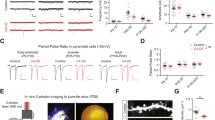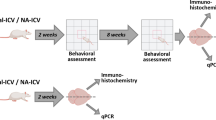Abstract
Natural killer (NK) cells have an important role in non-adaptative resistance to tumours and their metastatic spread in vivo1–5. Maturation of NK cells and the intensity of their activity are affected by many endogenous and external factors, as well as by regulatory cells1. The possibility that some effects of the central nervous system on tumour resistance are mediated via NK activity has also been suggested6. Destruction of the tuberoinfundibular region of the hypothalamus in rodents led to a significant increase in tumour growth7–9. We show here that destruction of its ventromedial, dorsomedial and arcuate nuclei persistently abrogates NK activity in mice. By contrast, cortical lesion and operative stress depress it partially, and for a brief period only. Abrogation is the result of a block of NK lineage maturation, causing a severe decrease in the number of large granular lymphocytes (LGL), a lymphocyte population associated with NK activity10,11. Macrophage, B- and T-lymphocyte functions, however, are not significantly affected. Agents inducing NK-cell maturation or activation such as poly inosinic-polycytidylic acid (poly(I:C), interferon (IFN) and interleukin-2 (IL-2) restore NK activity, and normalize the number of LGL.
This is a preview of subscription content, access via your institution
Access options
Subscribe to this journal
Receive 51 print issues and online access
$199.00 per year
only $3.90 per issue
Buy this article
- Purchase on Springer Link
- Instant access to full article PDF
Prices may be subject to local taxes which are calculated during checkout
Similar content being viewed by others
References
Herberman, R. B.(ed.) NK Cells and Other Natural Effector Cells (Academic, New York, 1982).
Riccardi, C., Puccetti, P., Santoni, A. & Herberman, R. B. J. natn. Cancer. Inst. 63, 1041–1047 (1979).
Karre, D., Klein, G. O., Kiessling, R. & Roder, J. C. Nature 284, 624–626 (1980).
Hanna, N. & Burton, R. C. J Immun. 127, 1754–1758 (1981).
Warner, J. F. & Dennert, G. Nature 300, 31–34 (1980).
Herberman, R. B. in Biological Mediators of Behaviour and Disease: Neoplasia (ed. Levy, S.) (Elsevier, Amsterdam, in the press).
Bindoni, M., Belluardo, N., Licciardello, S., Marchese, A. E. & Cicirata, F. Expl Neurol. 67, 433–437 (1980).
Bindoni, M., Belluardo, N., Licciardello, S., Marchese, A. E. & Cicirata, F. Neuroendocrinology 30, 88–93 (1980).
Bindoni, M., Belluardo, N., Marchese, A. E., Mudo′, G. & Laguidara, A. Neuroendocr. Lett. 3, 347–363 (1981).
Timonen, T., Saksela, E., Ranki, A. & Hayry, P. Cell Immun. 48, 133–140 (1979).
Kumagai, K., Itoh, K., Suzuki, R., Hinuma, S. & Saitoh, F. J. Immun. 129, 388–395d (1982).
Lehmann, A. Atlas Stereotaxique du Cerveau de la Souris (Centre National Recherche Scientifique, Paris, 1974).
Santoni, A., Riccardi, C., Sorci, V. & Herberman, R. B. J. Immun. 126, 2329–2332 (1980).
Giovarelli, M., Landolfo, S., Whitmore, A. C. & Forni, G. Eur. J. Cancer 18, 307–315 (1982).
Landolfo, S., Giovarelli, M., Viano, I. & Forni, G. Immunogenetics 9, 245–253 (1979).
Julius, M., Simpson, E. & Herzenberg, L. W. Eur. J. Immun. 3, 465–469 (1973).
Santoni, A., Herberman, R. B., Piccoli, M. & Ortaldo, J. Fedn Proc. 42, 1380 (1983).
Trinchieri, G. & Santoli, D. J. exp. Med. 143, 569–682 (1978).
Riccardi, C., Vose, B. M. & Herberman, R. B. in NK Cells and Other Natural Effector cells (ed. Herberman, R. B.) 909–915 (Academic, New York, 1982).
Djeu, J. Y., Heinbaugh, J. A., Holden, H. T. & Herberman, R. B. J. Immun. 122, 175–181 (1979).
Kuribayashi, K., Gillis, S., Kern, D. E. & Henney, C. S. J. Immun. 126, 2321–2326 (1981).
Saxena, Q. B., Saxena, R. K. & Adler, W. H. Int. Archs. Allergy appl. Immun. 67, 169–174 (1982).
Talwor, G. P. et al. Recent Prog. Horm. Res. 31, 141–174 (1975).
Fabris, N., Pierpaoli, W. & Sorkin, E. Clin. exp. Immun. 9, 227–240 (1971).
Mathews, P. M., Froelich, C. J., Sibbit, W. L. & Bankhurst, A. D. J. Immun. 130, 1658–1662 (1983).
Solomon, G. F. & Amkkraut, A. A. A. Rev. Microbiol. 35, 155–184 (1981).
Author information
Authors and Affiliations
Rights and permissions
About this article
Cite this article
Forni, G., Bindoni, M., Santoni, A. et al. Radiofrequency destruction of the tuberoinfundibular region of hypothalamus permanently abrogates NK cell activity in mice. Nature 306, 181–184 (1983). https://doi.org/10.1038/306181a0
Received:
Accepted:
Issue Date:
DOI: https://doi.org/10.1038/306181a0
This article is cited by
-
A Tribute to Elena Korneva: Reversal of Aging and Cancer by Pavlovian Conditioning: Neuroimmunomodulation – Some History
Neuroscience and Behavioral Physiology (2011)
-
Acute myeloid leukemia in a twin with a suprasellar arachnoid cyst: a possible correlation
Child's Nervous System (1994)
-
Immunological studies in patients with central nervous system tumors
Journal of Neuro-Oncology (1987)
-
Prophylactic effects of sodium and lithium hydroxybutyrate during stress-induced depression of normal killer cell activity in mice
Bulletin of Experimental Biology and Medicine (1986)
-
Endocrine regulation of the immune system
Klinische Wochenschrift (1986)
Comments
By submitting a comment you agree to abide by our Terms and Community Guidelines. If you find something abusive or that does not comply with our terms or guidelines please flag it as inappropriate.



